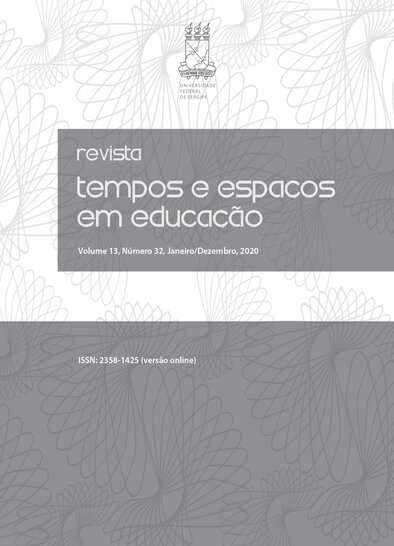Designing and writing an effective e-learning model(Ministry of Education)
DOI:
https://doi.org/10.20952/revtee.v13i32.14674Palavras-chave:
E-learning. Individual characteristics. Organizational characteristics. Infrastructure.Resumo
The purpose of this paper is to develop an effective e-learning model for descriptive-survey research of a practical type. The statistical population of this study is two groups. The first group consists of subject specialists and professors in the field of education and e-learning. In order to validate the initial framework and respond to the survey form, this study is conducted in this research. The sampling in this group is non-randomly targeted and based on the criteria. Is. The second group is all staff and managers with a total population of 12400, according to the chart number 375 as a result of the research. SPSS and Expert selection software have been used and analysis of data shows that individual characteristics include factors, individual characteristics, individual perceptions, individual skills, tolerance of ambiguity and risk, technical skills, proper character and culture. Organizational features include management support, social impacts, organizational leadership, organizational learning strategies, flexible organizational structure, organizational agility, financial management and appropriate funding, performance management structures, organizational learning and service quality management. . In the infrastructure features, including understanding the usefulness, understanding the ease of use, the IT infrastructure and Communication, required hardware, applications, information infrastructure, infrastructure and infrastructure responsiveness and customer relationship management, content production and infrastructure consistent with my country
Downloads
Referências
Alpour, A., and Shala, Baf AS. (2008). Ethics of virtual education. Journal of Ethics in Science and Technology, 43-51.
Al-rahmi, W. M., Othman, M. S., & Yusuf, L. M. (2015). The Effectiveness of Using E-Learning in Malaysian Higher Education: A Case Study Universiti Teknologi Malaysia. Mediterranean Journal of Social Sciences, 6(5), 625.
Amau, G (2013), factors affecting effective adoption of elearning in Kenyan universities: the case of jomo Kenyatta University of agriculture and technology, United States international university.
Baba Tabar darzi, H., Farshi M., Mokhtari Nouri, J., Mahmoudi H., and Daneshmandi, M. (2012). The Effect of Air ambulance services E-Learning on Nurses Learning. Quarterly Journal of Internal Nursing - Surgery, 42-48.
Chen R-S, Tsai C-C. Gender differences in Taiwan university students' attitudes toward web-based learning. CYBERPSYCHOL BEHAV. 2007; 10(36): 645-54.
Fathi and Ojargah, K., Pardakhtchi, M., and Rabiei, M. (2011). Evaluating the Effectiveness of Virtual Education Courses in Iran's Higher Education System (Case Study: Ferdowsi University of Mashhad). Journal of Technology and Communication in Educational Sciences, 6-24.
Garavan, T. N., Carbery, R. O., Malley, G., OíDonnell, D. (2010). Understanding Participation in E-learning in Organizations: A Large-Scale Empricial Study of Employees. International Journal of Training & Development, 14:3, 155-168.
Garrison DR, Kanuka H. Blended learning: Uncovering its transformative potential in higher education. The Internet and Higher Education 2004; 7(2): 95 – 105
Ghorbani, A.Jarjini, Z.Timouri, R. (2014) Comparison of the Effect of Electronic Education with Printing on Self-Care Knowledge in Diabetic Patients, Qazvin University of Medical Sciences, Volume 18, Number 6, (Pp. 63-66)
Hammad, R., Odeh, M. and Khan, Z. (2015) towards a model-based approach to evaluate the effectiveness of e learning. In: 9th European Conference on IS Management and Evaluation ECIME 2015, Uni-versity of the West of England, Bristol, UK, 21-22 September 2015. Bristol: Academic Conferences and Publishing Internationa l Limited, pp. 111-119 Available from: http://eprints.uwe.ac.uk/2696 9
Hosseini Nasab, Seyyed Davood and Hosseini, Zahra (2013), The Effectiveness of E-Learning on the Skills of Master Students of Islamic Azad University of Tabriz Branch in Locating and Accessing Information and Assessing Information and Resources, Education and Evaluation (Education Sciences) ): Summer 2013, Volume 6, Number 22; Pp 13-26.
Khairandish, Mehdi (2014), Explaining the Effective Factors on the Effectiveness of E-Learning in Master's Degrees in Science and Technology Universities in Tehran, IT management Journal.
Khuddad Hosseini, H., Noori, A., and Zabihi M. (2013). Acceptance of E-learning in Higher Education: Application of Flow Theory, Technology Acceptance Model and Quality of Electronic Services. Quarterly Journal of Research and Planning in Higher Education, 111-136.
Kumrow DE. Evidence-based strategies of graduate students to achieve success in a hybrid Web-based course. J NURS EDUC. 2007; 46(48): 140-5.
Lo, C. L. (2014). Building a Multi-Level Model of Individual E-Learning Effectiveness. The Journal of Human Resource and Adult Learning, 10(2), 71.
Noesgaard S. S. and Ørngreen R (2015). The Effectiveness of E -Learning: An Expl orative and Integrative Review of the Definitions, Methodologies and Factors that Promote e-Learning Effectiveness” The Electronic Journal of e-Learning Volume 13 Issue 4 2015, (pp278-290) available online at www.ejel.org
Ruiz JG, Mintzer MJ, Leipzig RM. The impact of e-learning in medical education. ACAD MED. 2006; 81(16): 207-12.
Simonson M, Smaldino S, Albright MJ, Zvacek S. Teaching and learning at a distance: Information Age Pub. 2014; 22(10): 17-23.
Zolfaghari, Mitra, Negarandeh, Reza, Fazlolah Ahmadi (2010), The Effectiveness of Combined Electronic Learning System in Teaching Nursing Students of Tehran University of Medical Sciences, Training in Medical Sciences.
Downloads
Publicado
Como Citar
Edição
Seção
Licença
À Revista Tempos e Espaços em Educação ficam reservados os direitos autorais pertinentes a todos os artigos nela publicados. A Revista Tempos e Espaços em Educação utiliza a licença https://creativecommons.org/licenses/by/4.0/ (CC BY), que permite o compartilhamento do artigo com o reconhecimento da autoria.



